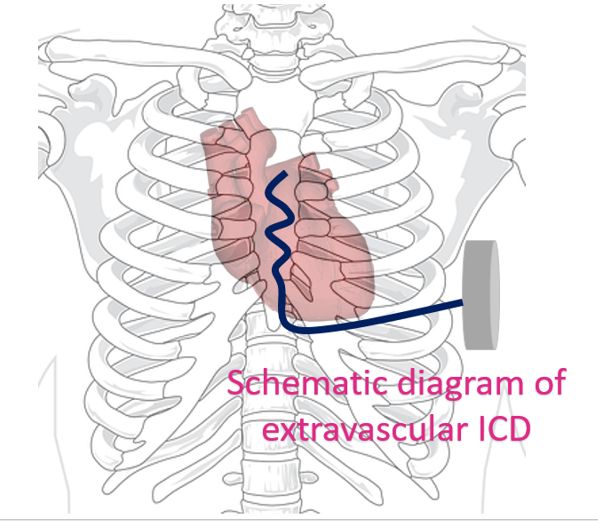Extravascular ICD – New medical device
Extravascular ICD – New medical device
എക്സ്ട്രാവാസ്കുലർ ഐസിഡി – പുതിയ മെഡിക്കൽ ഉപകരണം
एक्स्ट्रावास्कुलर आईसीडी – नया चिकित्सा उपकरण
ICD is short form for implantable cardioverter defibrillator. It is a life saving device, conventionally implanted under the skin of the chest below left collar bone and connected to the heart chamber by lead wires introduced through the blood vessels. ICD monitors the heart rhythm and treats them electrically when needed. ICD is also known as AICD as it functions automatically. ICD can suppress dangerous heart rhythms either by giving faster electrical signals known as overdrive pacing or by giving controlled electrical shocks within the heart.
Conventional ICDs are also called as transvenous ICDs as the leads are introduced to the heart through veins. Veins are blood vessels returning blood to the heart and lungs for oxygen enrichment. Presence of leads within the veins and heart can be a source of infection, clot formation, perforation and sometimes there could be displacement or fracture of leads. To avoid these problems of leads within the heart and blood vessels, a subcutaneous ICD was designed.
Subcutaneous ICD has a lead under the skin, near the breastbone. But as the breast bone is between the lead and the heart, it needed much higher electrical currents to function. Hence the device was larger and device longevity limited due to higher battery drain. Moreover, it could not deliver overdrive pacing to suppress fast heart rhythms without giving a shock. If a fast rhythm can be terminated without giving a shock, battery drain is less and it avoids the painful shock delivery.

The novel concept of extravascular ICD is to counter the shortcomings of transvenous ICDs and subcutaneous ICDs. In extravascular ICD, the lead is implanted under the breastbone, over the heart. This avoids the presence of bone between the lead and the heart, improving the electrical performance of the device. Extravascular ICD can suppress fast heart rhythms by overdrive pacing as well as give successful shocks at lower energies comparable to transvenous ICDs. But implanting the lead under the breastbone needs extra training for the cardiologist who implants the device, under the direct supervision of a cardiac surgeon initially.
As a novel concept, extravascular ICD has been successfully tested in an initial set of around 300 patients in the Extravascular ICD Pivotal Study. The procedure was done either in cardiac catherization laboratory or hybrid operating room by cardiologists who underwent a structured hands-on training program. The novel concept of extravascular ICD looks promising. Of course, only time will tell whether it will actually replace subcutaneous and transvenous ICDs in future.


